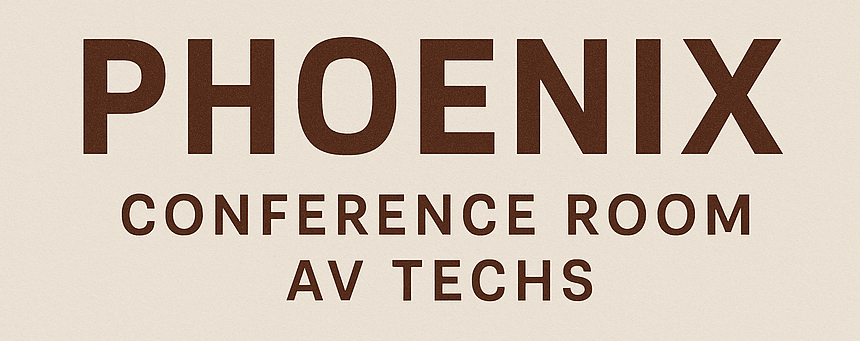Phoenix Conference Room Audio Video Solutions: Optimizing Collaboration with Cutting-Edge AV Technology
Introduction
Modern businesses in Phoenix face growing demands for efficient collaboration and high-quality communication. A well-designed conference room equipped with integrated audio and video (AV) solutions can significantly improve meeting productivity, reduce technical issues, and foster seamless teamwork. This article explores the latest conference room AV solutions in Phoenix, from video conferencing systems to integrated control panels, and offers expert insights on selecting, installing, and optimizing your AV setup.
Table of Contents
- What Are Conference Room Audio Video Solutions?
- Benefits of Implementing AV Solutions in Phoenix Businesses
- Key Components of Modern AV Systems
- Choosing the Right AV Equipment for Your Conference Room
- Integration and Installation Considerations
- Common Challenges and How to Overcome Them
- Future Trends in Conference Room AV Technology
- FAQs
- Conclusion
What Are Conference Room Audio Video Solutions?
Conference room AV solutions encompass hardware, software, and integrated systems that allow teams to communicate effectively through audio, video, and collaboration tools. These include:
- Video conferencing systems (Zoom Rooms, Microsoft Teams Rooms, Cisco Webex)
- High-definition displays and projectors
- Professional-grade microphones and speakers
- Control systems and touch panels
- Network cabling and AV integration
AV solutions are designed to provide clear audio, sharp visuals, and reliable connectivity, ensuring meetings run smoothly without technical interruptions.
Benefits of Implementing AV Solutions in Phoenix Businesses
- Enhanced Collaboration: Real-time video and audio enable remote teams to contribute effectively.
- Improved Productivity: Streamlined technology reduces downtime and technical troubleshooting.
- Professional Image: High-quality AV systems create a polished impression for clients and partners.
- Scalability: Systems can grow with your business and integrate with future technologies.
- Cost Savings: Efficient AV systems reduce travel costs by supporting remote meetings.
Statistic Highlight: According to a 2023 report by Frost & Sullivan, companies using integrated AV solutions experience a 35% increase in meeting efficiency.
Key Components of Modern AV Systems
- Displays & Projectors – Ultra HD monitors, LED walls, or 4K projectors for clear visuals.
- Audio Equipment – Ceiling microphones, boundary microphones, and advanced speakers for crystal-clear sound.
- Video Conferencing Cameras – PTZ cameras and AI-enabled tracking cameras to capture all participants.
- Control Systems – Touch panels and automation software to manage lighting, AV inputs, and screens.
- Connectivity Infrastructure – Structured cabling (Cat6, fiber optic) and network switches ensuring stable connections.
- Collaboration Tools – Software platforms like Zoom, Teams, and Webex integrated with AV hardware.
Choosing the Right AV Equipment for Your Conference Room
Factors to consider:
- Room Size & Layout: Determines number of microphones, camera placement, and display size.
- User Experience: Ensure intuitive operation to reduce learning curves.
- Integration Needs: Compatibility with existing networks and cloud services.
- Budget & ROI: Balance cost with long-term productivity gains.
- Vendor Support: Reliable local support in Phoenix for installation, maintenance, and upgrades.
Integration and Installation Considerations
Successful AV installation requires careful planning:
- Structured Cabling: Use certified low-voltage cabling for optimal performance.
- Power Management: Ensure consistent power supply for all AV equipment.
- Acoustic Treatment: Minimize echo and enhance sound quality with proper room design.
- Lighting & Video Quality: Adjust lighting to avoid glare and improve camera output.
- System Testing: Conduct thorough testing to confirm functionality before deployment.
Common Challenges and How to Overcome Them
- Connectivity Issues: Upgrade network infrastructure and implement redundant connections.
- User Adoption: Offer staff training and simple interfaces.
- Compatibility Problems: Choose interoperable hardware and software solutions.
- Budget Constraints: Start with essential components, then expand gradually. Conference Room AV Systems
Future Trends in Conference Room AV Technology
- AI-Powered Collaboration: Automated speaker tracking and transcription services.
- Wireless AV Solutions: Reduced cabling complexity with high-speed wireless systems.
- Hybrid Meeting Rooms: Seamless integration of in-person and remote participants.
- Sustainability Focus: Energy-efficient displays and low-power devices.
FAQs
Q1: How much does it cost to install a conference room AV system in Phoenix?
A: Costs vary from $5,000 for small rooms to $50,000+ for large boardrooms, depending on equipment quality and room complexity.
Q2: Can existing rooms be retrofitted with AV solutions?
A: Yes, with proper planning, cabling, and system integration, existing conference rooms can be upgraded efficiently.
Q3: How do I choose between Zoom Rooms and Microsoft Teams Rooms?
A: Consider your organization’s primary collaboration platform, hardware compatibility, and user experience requirements.
Conclusion
Investing in conference room audio video solutions in Phoenix is a strategic move for businesses seeking to enhance collaboration, improve productivity, and future-proof their communication infrastructure. By carefully selecting equipment, optimizing installation, and adopting scalable technologies, organizations can create conference environments that are efficient, professional, and technology-driven. Audio Video Solutions
